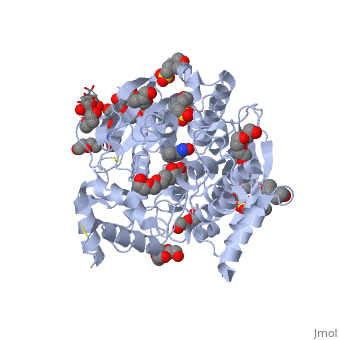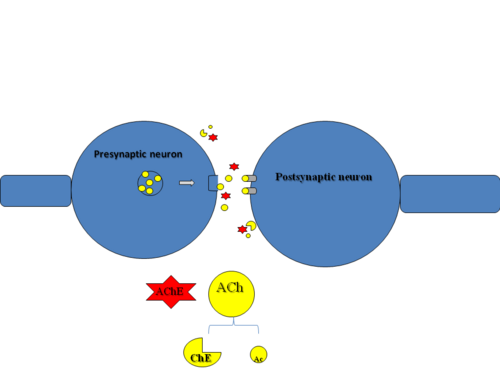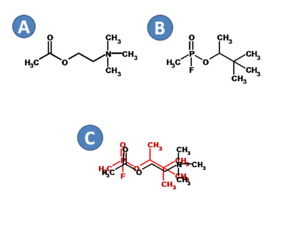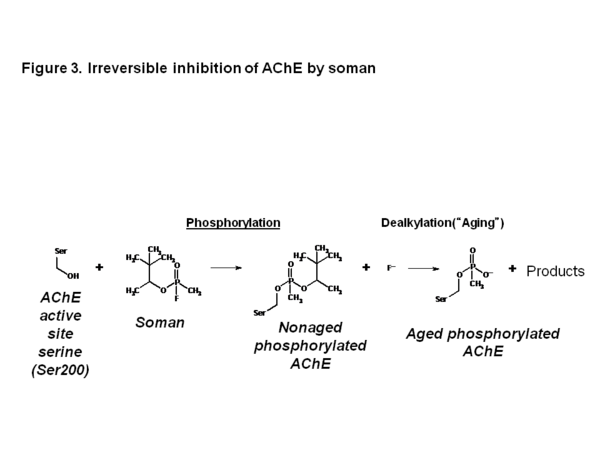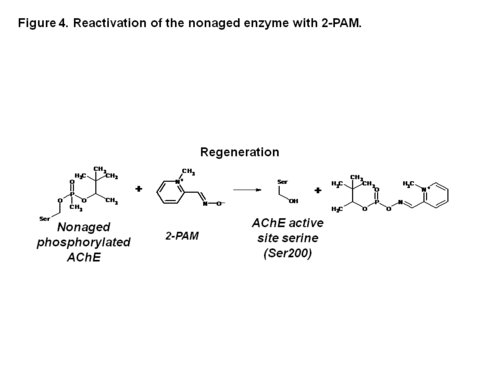Acetylcholinesterase inhibitors
From Proteopedia
(Difference between revisions)
| Line 1: | Line 1: | ||
<StructureSection load='2wg1' size='500' side='right' caption='Structure of AChE with Soman and 2 PAM (PDB entry [[2wg1]])' scene=''> | <StructureSection load='2wg1' size='500' side='right' caption='Structure of AChE with Soman and 2 PAM (PDB entry [[2wg1]])' scene=''> | ||
| - | '''Acetylcholinesterase (AChE)''' is an enzyme that catalyses the hydrolysis of the neurotransmitter acetylcholine (ACh) to acetate and choline, and plays a crucial role in terminating the nerve impulse at cholinergic synapses.Reversible inhibitors of AChE are used to treat diseases such as Alzheimer’s disease (AD) and Parkinson’s disease. Conversely, irreversible inhibition of AChE by organophosphates (<scene name='Acetylcholinesterase_inhibitors/Phosphorus/3'>OP</scene>), such as soman, can lead to death. In this process, the OP covalently attaches to a <scene name='Acetylcholinesterase_inhibitors/Serine_residue/5'>serine residue</scene> in the active site to generate a <scene name='Acetylcholinesterase_inhibitors/Ser200_and_op/1'>phosphorylated enzyme</scene>. Subsequently, the OP is dealkylated, a process that is termed aging, generating a form of the enzyme that cannot be reactivated by antidotes, such as pralidoxime (2-PAM). Recently, the structures of Torpedo californica (Tc) AChE conjugated with soman, in both the non-aged and aged forms, and 2-PAM have been solved. From these structures, it is clear that a structural reorientation of His440, a component of the active site, occurs during the aging process. Additionally, the structure of the ternary complex of the aged AChE complex with <scene name='Acetylcholinesterase_inhibitors/2_pam/1'>2-PAM</scene>, revealed that the oxime functional group is not optimally positioned for nucleophilic attack on the phosphorous atom.1 | + | '''Acetylcholinesterase (AChE)''' is an enzyme that catalyses the hydrolysis of the neurotransmitter acetylcholine (ACh) to acetate and choline, and plays a crucial role in terminating the nerve impulse at cholinergic synapses. Reversible inhibitors of AChE are used to treat diseases such as Alzheimer’s disease (AD) and Parkinson’s disease. Conversely, irreversible inhibition of AChE by organophosphates (<scene name='Acetylcholinesterase_inhibitors/Phosphorus/3'>OP</scene>), such as soman, can lead to death. In this process, the OP covalently attaches to a <scene name='Acetylcholinesterase_inhibitors/Serine_residue/5'>serine residue</scene> in the active site to generate a <scene name='Acetylcholinesterase_inhibitors/Ser200_and_op/1'>phosphorylated enzyme</scene>. Subsequently, the OP is dealkylated, a process that is termed aging, generating a form of the enzyme that cannot be reactivated by antidotes, such as pralidoxime (2-PAM). Recently, the structures of Torpedo californica (Tc) AChE conjugated with soman, in both the non-aged and aged forms, and 2-PAM have been solved. From these structures, it is clear that a structural reorientation of His440, a component of the active site, occurs during the aging process. Additionally, the structure of the ternary complex of the aged AChE complex with <scene name='Acetylcholinesterase_inhibitors/2_pam/1'>2-PAM</scene>, revealed that the oxime functional group is not optimally positioned for nucleophilic attack on the phosphorous atom.1 |
| - | ACh is a neurotransmitter that is essential for nerve transmission at the cholinergic synapse (Figure 1). In the beginning a nerve impulse reaches the presynaptic membrane which acts upon vesicles that contain ACh. Then ACh is | + | ACh is a neurotransmitter that is essential for nerve transmission at the cholinergic synapse (Figure 1). In the beginning a nerve impulse reaches the presynaptic membrane which acts upon vesicles that contain ACh. Then ACh is released into the synapse. Afterwards, ACh diffuses across the synapse where it binds and activates receptors on the postsynaptic neuron. As a result a nerve impulse is initiated. It is also important to terminate the impulse by breaking down ACh into acetyl and choline portions by AChE. |
[[Image:slide3.png|right|500px|thumb| [[Figure 1]]]] | [[Image:slide3.png|right|500px|thumb| [[Figure 1]]]] | ||
| - | AChE is a very fast enzyme and even though the active site is at the bottom of a deep (~20 Â) and narrow (~5 Â) gorge,it has several features that ensure rapid catalysis.1 Primarily, | + | AChE is a very fast enzyme and even though the active site is at the bottom of a deep (~20 Â) and narrow (~5 Â) gorge, it has several features that ensure rapid catalysis.1 Primarily, |
1. 14 aromatic residues line the active site and filter ACh, by cation-π interactions, from the surface of AChE to the <scene name='Acetylcholinesterase_inhibitors/Catalytictriad/2'>catalytic triad</scene> (Ser200, Glu327 and His440).1 | 1. 14 aromatic residues line the active site and filter ACh, by cation-π interactions, from the surface of AChE to the <scene name='Acetylcholinesterase_inhibitors/Catalytictriad/2'>catalytic triad</scene> (Ser200, Glu327 and His440).1 | ||
2. AChE has a dipole that helps "attract" to the active site 1 | 2. AChE has a dipole that helps "attract" to the active site 1 | ||
| - | Due to the decrease in levels of ACh found in patients with Alzheimer's Disease (AD) and Parkinson's disease(PD) there is a need to increase the amount of ACh available in the post-synaptic neuron. By reversibly inhibiting AChE it is possible to stop the breakdown of ACh and thereby increase its levels at the synapse. Therefore AChE is the target of reversible therapeutic agents that treat AD and PD. These agents include-donepezil,rivastigmine and galantamine.6 There are certain agents that are able to bind to AChE in an irreversible manner. These agents are from a class of organophosphates (OP) and include insecticides and chemical warfare agents such as Malathion and Echothiophate. When the reaction becomes irreversible it can ultimately lead to a person's death, unless treated right away. The way OP | + | Due to the decrease in levels of ACh found in patients with Alzheimer's Disease (AD) and Parkinson's disease (PD) there is a need to increase the amount of ACh available in the post-synaptic neuron. By reversibly inhibiting AChE it is possible to stop the breakdown of ACh and thereby increase its levels at the synapse. Therefore AChE is the target of reversible therapeutic agents that treat AD and PD. These agents include-donepezil, rivastigmine and galantamine.6 There are certain agents that are able to bind to AChE in an irreversible manner. These agents are from a class of organophosphates (OP) and include insecticides and chemical warfare agents such as Malathion and Echothiophate. When the reaction becomes irreversible it can ultimately lead to a person's death, unless treated right away. The way OP poisoning is treated is with nucleophilic reactivators such as 2-PAM.6 |
OPs are irreversible inhibitors of AChE and are used as both insecticides and chemical warfare agents. The chemical structures of ACh and soman have tremendous similarity, revealing why soman reacts with AChE so efficiently (Figure 2). | OPs are irreversible inhibitors of AChE and are used as both insecticides and chemical warfare agents. The chemical structures of ACh and soman have tremendous similarity, revealing why soman reacts with AChE so efficiently (Figure 2). | ||
| Line 21: | Line 21: | ||
The irreversible inhibition of AChE by soman is a multi-step process <1> (Figure 3). | The irreversible inhibition of AChE by soman is a multi-step process <1> (Figure 3). | ||
First, the catalytic serine residue (Serine 200) performs a nucleophilic | First, the catalytic serine residue (Serine 200) performs a nucleophilic | ||
| - | attack on the phosphorus atom of soman,generating the phosphorylated enzyme. | + | attack on the phosphorus atom of soman, generating the phosphorylated enzyme. |
Second, the pinacolyl group departs, which signifies “aging.” | Second, the pinacolyl group departs, which signifies “aging.” | ||
At this point, Aged phosphorylated AChE can not be reactivated. 1 | At this point, Aged phosphorylated AChE can not be reactivated. 1 | ||
| Line 33: | Line 33: | ||
2-PAM is a nucleophile that can reactivate non-aged form of the | 2-PAM is a nucleophile that can reactivate non-aged form of the | ||
| - | enzyme. Before aging occurs,reactivation of AChE can occur through | + | enzyme. Before aging occurs, reactivation of AChE can occur through |
nucleophilic attack of the oxime group of 2-PAM on | nucleophilic attack of the oxime group of 2-PAM on | ||
the phosphorus atom of the phosphonyl adduct, resulting in its | the phosphorus atom of the phosphonyl adduct, resulting in its | ||
| Line 45: | Line 45: | ||
'''Next Generation Antidotes for OP Poisoning''' | '''Next Generation Antidotes for OP Poisoning''' | ||
| - | As described above, 2-PAM could reactivate nonaged AChE , | + | As described above, 2-PAM could reactivate nonaged AChE, |
however aged AChE enzyme at present can not be reactivated. Therefore, scientists are trying to | however aged AChE enzyme at present can not be reactivated. Therefore, scientists are trying to | ||
find new reactivators that will fill that niche. Structure of 2-PAM could help in the synthesis | find new reactivators that will fill that niche. Structure of 2-PAM could help in the synthesis | ||
| Line 93: | Line 93: | ||
Professor Joel L. Sussman, Weizmann Institute of Science | Professor Joel L. Sussman, Weizmann Institute of Science | ||
| - | Professor Lars Westblade,Touro College of Pharmacy | + | Professor Lars Westblade, Touro College of Pharmacy |
Naomi Arye, Touro College of Pharmacy | Naomi Arye, Touro College of Pharmacy | ||
| Line 109: | Line 109: | ||
Conjugate with Pralidoxime. J. Med. Chem.52, 7593-7603 | Conjugate with Pralidoxime. J. Med. Chem.52, 7593-7603 | ||
| - | 2. Greenblatt, H.M., Dvir, H., Silman, I., Sussman, J.L. ( 2003). A Multifaceted Target for | + | 2. Greenblatt, H.M., Dvir, H., Silman, I., Sussman, J.L. (2003). A Multifaceted Target for |
Structure-Based Drug Design of Acetylcholinesterase Agents for the treatment of Alzheimer’s Disease. | Structure-Based Drug Design of Acetylcholinesterase Agents for the treatment of Alzheimer’s Disease. | ||
J. of Molecular Neuroscience. 20: 369-383 | J. of Molecular Neuroscience. 20: 369-383 | ||
Revision as of 17:48, 5 July 2011
| |||||||||||
